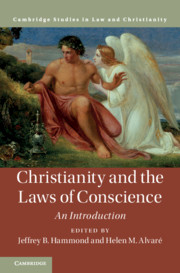Book contents
- Christianity and the Laws of Conscience
- Law and Christianity
- Christianity and the Laws of Conscience
- Copyright page
- Dedication
- Contents
- Contributors
- Acknowledgments
- Introduction
- Part I Themes in Understandings of Conscience in Christianity
- Part II Conscience According to Major Figures and Traditions
- Part III Applied Topics in Law and Conscience
- 15 Liberty of Conscience, Free Exercise of Religion, and the US Constitution
- 16 Religious Conscience Protections in American State Constitutions
- 17 Forced Conformity or Accommodation?
- 18 Christian Conscience and Sexual Expression Rights
- 19 Conscience and the Roman Catholic “Just War” Tradition
- 20 Institutional Conscience, Corporate Persons, and Hobby Lobby
- 21 Religion, Conscience, and the Law
- Index
- References
19 - Conscience and the Roman Catholic “Just War” Tradition
from Part III - Applied Topics in Law and Conscience
Published online by Cambridge University Press: 12 June 2021
- Christianity and the Laws of Conscience
- Law and Christianity
- Christianity and the Laws of Conscience
- Copyright page
- Dedication
- Contents
- Contributors
- Acknowledgments
- Introduction
- Part I Themes in Understandings of Conscience in Christianity
- Part II Conscience According to Major Figures and Traditions
- Part III Applied Topics in Law and Conscience
- 15 Liberty of Conscience, Free Exercise of Religion, and the US Constitution
- 16 Religious Conscience Protections in American State Constitutions
- 17 Forced Conformity or Accommodation?
- 18 Christian Conscience and Sexual Expression Rights
- 19 Conscience and the Roman Catholic “Just War” Tradition
- 20 Institutional Conscience, Corporate Persons, and Hobby Lobby
- 21 Religion, Conscience, and the Law
- Index
- References
Summary
Joseph Capizzi lays out Catholic just war theory and its tie to the Church’s teaching on conscience. The scriptural context for just war teaching is Jesus’ discourse in John 14, in which he promises to give peace, but not as world gives. The world’s peace is often tainted with the temptation to sacrifice neighbors and innocents. War can be an expression of conscience, but only if ordered toward peace, guided by morality, and open always to the conversion of self and neighbor. The just war approach excludes objectives such as vengeance. It prohibits direct harm to noncombatants. Both sides in a conflict are potential members of the community for whom peace is a goal. As against any duty of military service, US law currently protects the conscience of conscientious objectors (COs) who oppose all wars on the basis of religion or nonreligious morals. It does not, however, protect “selective conscientious objectors” (SCOs), those who oppose only unjust wars. Finally, consistent application of conscience protection instructs that soldiers with moral agency as rational beings with a conscience, should refuse to follow orders against their conscience and the moral law.
Keywords
- Type
- Chapter
- Information
- Christianity and the Laws of ConscienceAn Introduction, pp. 375 - 394Publisher: Cambridge University PressPrint publication year: 2021

